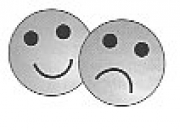
|
SCE-1003355
Balls - Happy and Unhappy$17.50
Balls - Happy and Sad. 2 identical balls of same mass, appearance and density. When dropped 1 bounces back while the other hits floor and stops. With instructions. Although the two balls have some similar physical properties, such as size, color, and density, they differ greatly in elasticity. The one which bounces demonstrates an almost perfect elastic collision with a hard surface. Very little of its kinetic energy is converted into heat in the collision. This ball is often referred to as a 'super ball'. The ball which does not bounce demonstrates an almost perfect inelastic collision. Most of the kinetic energy is converted into heat. The ball which bounces is made from polyneoprene, which has large chlorine groups to restrict rotation on every fourth carbon in the long chain. Numerous cross links between polymer chains restrict the slipping of one chain past another. With little bond rotation and chain slippage, the energy of the fall cannot easily be converted into heat. To conserve the energy of the fall, the molecules move and then quickly return to their original position. At room temperature, consequently, the ball deforms on impact and then immediately returns to a spherical shape, cause the ball to bounce back to almost the same height as dropped. This phenomena is very temperature dependent. If cooled to about -40o C, these collisions become inelastic and the ball will not bounce well. The ball which does not bounce well is make from polynorbornene, which has a 5-membered ring as part of the chain structure. Although this group restricts the movement, the molecule absorbs most of the energy of a fall. With more degrees of molecular freedom, this polymer does not quickly return to its original shape. Thus, at room temperature, the energy of the fall is absorbed within the molecules in the form of heat. Even cooling this ball in the freezer changes its elastic properties so that a small bounce can be observed.
|




